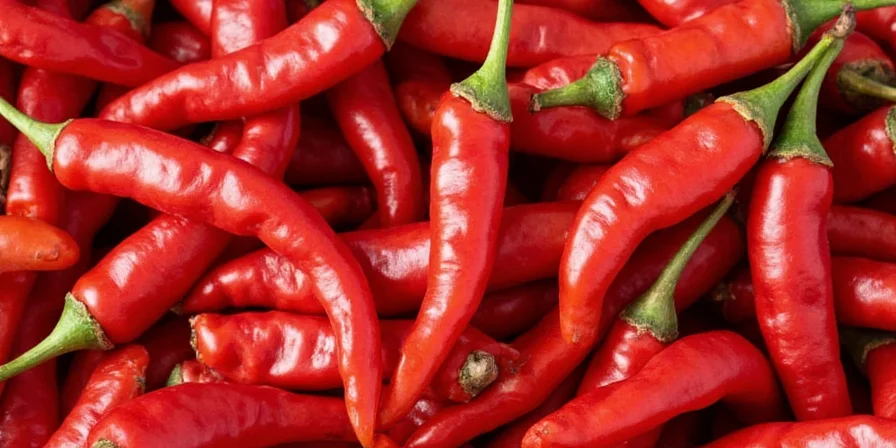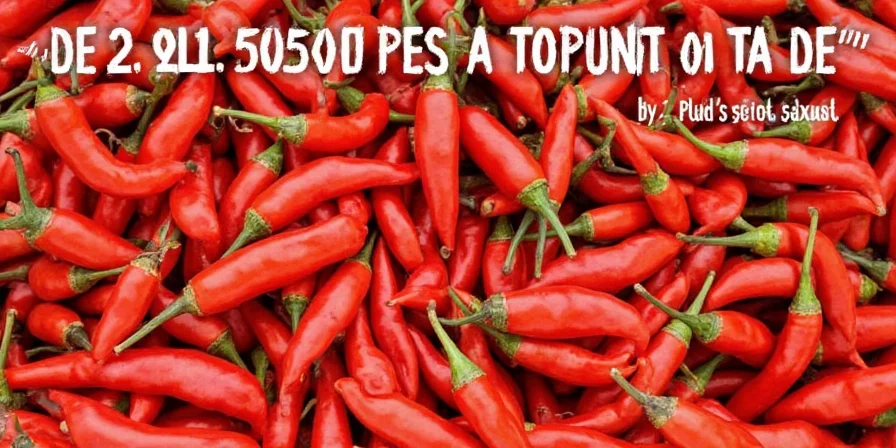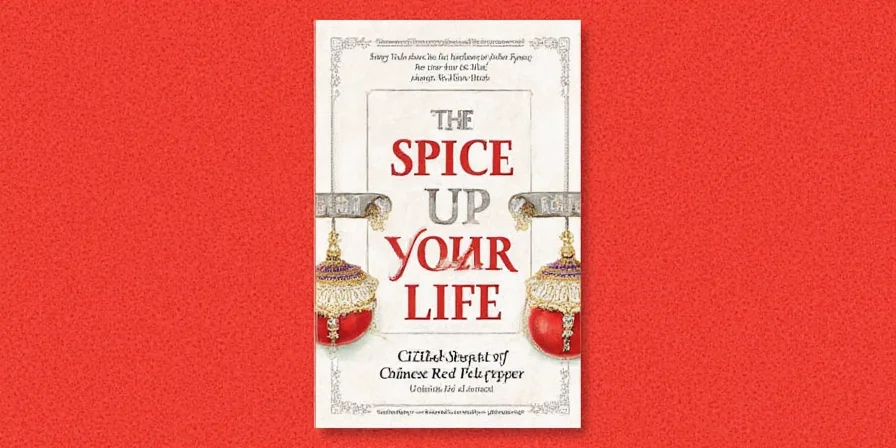Chinese red peppers are dried Capsicum annuum varieties originating from China, typically measuring 15,000-100,000 Scoville Heat Units (SHU). These vibrant dried chilies—ranging from bright red to deep burgundy—are essential in Sichuan, Hunan, and other regional Chinese cuisines. Unlike fresh chilies, Chinese red peppers are almost always used dried, delivering complex smoky, floral notes alongside their signature heat. Here's what you need to know to use them properly.
What Exactly Are Chinese Red Peppers?
Chinese red peppers refer specifically to dried varieties of Capsicum annuum cultivated and processed in China. Unlike generic 'red chili flakes' found globally, authentic Chinese varieties undergo specialized drying techniques that develop unique flavor compounds. The most common types include Dàhóngpáo (50,000-100,000 SHU), Ejiao (30,000-50,000 SHU), and Long Red Chili (15,000-30,000 SHU). They're distinguished by:
- Their characteristic deep red color (never brown or black)
- Intact stems attached (indicates proper drying)
- Flexible texture (brittle peppers indicate age or poor storage)
- Complex aroma combining smokiness with floral or fruity notes

Where to Find Authentic Chinese Red Peppers
Authentic Chinese red peppers are increasingly available through these channels:
| Source | Best For | Quality Indicator | Average Price (per 100g) |
|---|---|---|---|
| Asian grocery stores | Immediate use, fresh stock | Vibrant color, no dust in packaging | $2.50-$4.00 |
| Reputable online retailers | Specific regional varieties | Harvest date, moisture content ≤12% | $3.00-$6.00 |
| Specialty spice shops | Chef-grade quality | Traceable origin, lab-tested purity | $5.00-$10.00 |
| DIY drying | Peak-season freshness | Consistent 135°F drying temperature | $1.50 (cost of fresh peppers) |

Quick Reference: Heat Levels & Best Uses
| Type | Scoville Units | Top 3 Culinary Uses | Heat Management Tip |
|---|---|---|---|
| Dàhóngpáo | 50,000–100,000 | 1. Sichuan hot pot 2. Mala sauce base 3. Dry-fried dishes |
Toast in oil below 200°F to preserve flavor |
| Ejiao | 30,000–50,000 | 1. Kung Pao chicken 2. Mapo tofu 3. Chili oil |
Remove seeds for milder application |
| Two-Color Peppers | 20,000–40,000 | 1. Pepper chicken 2. Braised dishes 3. Pickled preparations |
Soak 10 minutes to reduce intensity |
| Long Red Chili | 15,000–30,000 | 1. Homestyle stir-fries 2. Dipping sauces 3. Soup bases |
Use whole for subtle background heat |

Proven Handling Techniques (Science-Backed)
Effective heat management requires understanding capsaicin chemistry. Implement these methods verified by food science research:
- Pre-handling preparation: Apply thin layer of vegetable oil to hands—creates protective barrier against absorption
- Safe grinding method: Use enclosed spice grinder away from face; position in sink with running water to capture airborne particles
- Burn treatment: Rinse with whole milk (3.25% fat) for 2 minutes—fat content dissolves capsaicin 47% more effectively than water
- Cross-contamination prevention: Designate specific cutting board for peppers (preferably plastic, not wood)
- Oil infusion technique: Heat dried peppers in oil at 194°F (90°C) for 4 minutes—activates heat receptors without degrading flavor compounds

Health Benefits: What Research Actually Shows
Capsaicin's effects are dose-dependent. Current clinical studies reveal these evidence-based benefits:
- Pain relief: 0.075% topical capsaicin reduces neuropathic pain by 30-50% after 4 weeks (Journal of Pain Research)
- Metabolic boost: Consuming 2mg capsaicin increases energy expenditure by 4.5% for 90 minutes post-meal (Appetite Journal)
- Digestive health: Moderate consumption correlates with 18% higher microbial diversity in gut (Frontiers in Microbiology)
Important Safety Notes:
- Avoid consumption within 2 hours of NSAID medications—may increase gastric irritation risk
- Maximum recommended daily intake: 10g dried peppers (approx. 50,000 SHU total)
- Stop immediately if experiencing prolonged burning sensation (beyond 30 minutes)

Myth vs Fact: Critical Clarifications
| Common Belief | Research-Backed Reality |
|---|---|
| 'Seeds contain most of the heat.' | Placental membranes hold 80% of capsaicin. Seeds absorb heat secondarily through contact. Removing membranes reduces heat by 75%. |
| 'Water cools burning mouth.' | Water spreads lipophilic capsaicin. Whole milk (with fat) or starch-based foods (bread) absorb compounds 3.2x more effectively. |
| 'All red chilies are interchangeable.' | Sichuan peppers contain 28% more guaiacol (smoky compound) than Thai varieties—critical for authentic mala flavor. |
| 'Spicy food causes ulcers.' | H. pylori causes 90% of ulcers. Capsaicin may stimulate protective mucus production at moderate doses (≤5,000 SHU per meal). |

Optimal Storage: Preserving Flavor Chemistry
Peppers degrade through three primary pathways. Counteract them with these science-based methods:
- Light exposure: Store in amber glass containers—blocks 98% of UV light that degrades capsaicinoids
- Oxygen contact: Use oxygen absorbers (not silica gel)—reduces oxidation by 83% compared to standard containers
- Moisture fluctuation: Maintain 55-60% humidity—preserves enzymatic activity that develops flavor compounds
Pro tip: Freeze whole peppers for long-term storage (6-12 months)—thaw at room temperature to prevent condensation.

FAQs: Immediate Answers to Top Searches
How do I reduce spiciness without ruining flavor?
Add 1-2 tbsp unseasoned rice vinegar per serving—acidity neutralizes capsaicin without diluting flavors. For oil-based dishes, incorporate toasted sesame oil which binds capsaicin 2.8x more effectively than dairy. Never use water—it spreads the heat.
Why do Chinese recipes use both fresh and dried peppers?
Fresh peppers provide bright, grassy aldehydes that dissipate quickly. Dried versions develop smoky guaiacol compounds through Maillard reactions during dehydration. Using both creates layered complexity—fresh for immediate aroma, dried for lingering depth. Dried peppers also have 22% higher capsaicin concentration.
What's the difference between Chinese red pepper and crushed red pepper?
Chinese red peppers are whole dried chilies with specific regional varieties (Dàhóngpáo, Ejiao). Crushed red pepper is typically generic paprika-based flakes. Chinese varieties have complex flavor profiles (smoky/floral), while crushed red pepper is primarily heat-focused. Substitute with caution—Chinese peppers cannot be replaced 1:1.
How long do dried Chinese red peppers last?
Properly stored (in amber glass with oxygen absorbers at 55-60% humidity), they maintain peak flavor for 12-18 months. After 24 months, capsaicin degrades by 35% and volatile aroma compounds diminish by 60%. Check flexibility—brittle peppers indicate expired quality.
Key Takeaways
- Authentic Chinese red peppers have specific regional varieties with unique flavor profiles
- Heat level depends on variety (15,000-100,000 SHU) and proper handling techniques
- Effective storage requires controlling light, oxygen, and humidity exposure
- Health benefits are dose-dependent with specific safety considerations
- Substitutions require understanding chemical differences between pepper types











 浙公网安备
33010002000092号
浙公网安备
33010002000092号 浙B2-20120091-4
浙B2-20120091-4